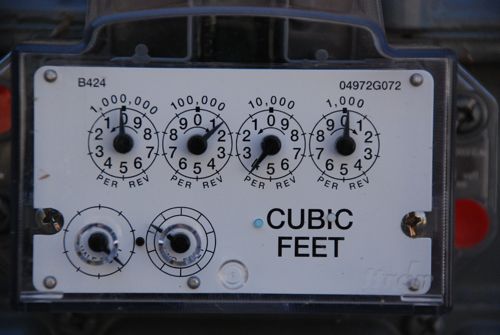
[UPDATE: Smart meters are now set to become the norm in UK households. You can read more about them here.]
Why might you need to change your meters?
There are lots of situations where you might need to switch meters including: when you have had storage heaters replaced with another form of heating, when you have switched to storage heaters from other electric heating, when you have drastically changed the way you use your energy or where you have a historic system (just moved in to a new property).
 Is it worth getting your meter changed?
Is it worth getting your meter changed?
We have covered the value of economy 7 meters before, but just to highlight the key point, if you use more than 40% of your electricity at night (between 12 and 7am), it is worth staying on the dual rate tariff, or indeed moving to it. If you are using less than that, you are better off moving to a single rate tariff.
It is surprising how much you could save, and we have seen customers switching both ways that have saved £200 a year by switching from dual to single or vice versa. So it really is a good idea for some households. You can work out the savings by taking a close look at your bills, or even speaking to your provider.
How easy is it to change meters?
Depending on your supplier, this might be as simple as a phone call and a change of tariff, or it could mean changing the meter over to a new single rate model. It is certainly possible for the supplier just to take 2 readings instead of one and charge the same rate for both, but some companies do not like to do this and will want you to switch.
There does not seem to be a particular pattern here – some providers will be happy to just change your tariff, whilst others insist on a new meter. If you are switching providers, try calling both your old and new company before the switch happens to see if you can get it done cheaper by either company.
Does it cost to get your meter changed?
Most energy companies will charge you to switch to a different type of meter, whether that be single to dual, or dual to single. This can vary from £60 to a few hundred, but some providers will make the switch for free.
2 meters vs. dual meter
This is less common but it can complicate the situation, depending on a number of factors. Some customers have 2 meters in one house, one for day rate and one for night rate, whilst other customers will have 2 meters with different appliances running off of each meter – usually because the property used to be 2 flats for example. The approach for you here should still be to try your energy provider as a first option, but if you don’t get any joy, you should try contacting your regional electricity network supplier, which is often written somewhere near your meters. They own the meters and will likely be able to help you get your meters changed. If you have 2 separate MPAN numbers, it is worth trying to get these combined as you will not be paying 2 separate standing charges!
Think carefully before switching meters
Changing your meter over can be a really drawn out and frustrating process. The energy companies often take weeks to get an engineer to you, and there can be complicating factors, so make sure the savings are there first before you proceed. It really can be worth it for some customers, whilst others are better sticking with what they’ve got.
Think we missed something? Do you have a different opinion?
Comment below to get your voice heard…











Hi. I moved to all electric property 4 months ago and have THREE meter readings, it’s supposed to be a super deal with SSE. I have no use for the so called super deal meter as I can’t possibly only do my washing between midnight and 7am as I have a double incontinent daughter and I’m fed up of waking up in total panic when I’ve overslept, . Also it seems like I can’t even change suppliers, and I need cheapest possible. I don’t have a dishwasher or tumble drier etc. What can i do
My friend has Total Heating Total Control tariff and storage radiators and it is estimated to be going to cost her nearly £4000.00 next year Most of her use is at the higher tariff.
Can she change her meters to get the normal or maybe an economy 7 tariff?
I recently moved from THTC to Economy 8 with SSE, but have seen an unexpected 2 – 3 times increase in energy used. Cause: my Dimplex storage heaters radiate heat while they’re charging so now heat empty rooms for 8 hours overnight, whereas with THTC the heaters are charged up to 3 times per day depending on the weather, so the heaters would radiate heat into the rooms while they were charging during the day. With the large amount of renewable energy now being generated, a number of green suppliers are charging less for their standard rate than most suppliers charge for their overnight rates, removing the “benefit” of dual rate electricity and storage heaters. So, investigate the market using any of the comparison web-sites and if you find the same, ask if they offer the option to charge you the one cheaper rate for both supplies. Alternatively, you can ask your current supplier (SSE) to move you to a single rate meter, and once that’s done, move to the cheaper supplier (this means you can have your storage heaters on whenever you want, by switching on and off at the wall, or by installing smartplugs and controlling them from your mobile phone. This will probably involve some cost to you. SSE replaced the main meter(s) for free, but the internal board within my house had to be rewired by an electrician to connect the storage heaters into the main supply – comfortably completed within an hour.
I have a southern electric old type smart meter but I’m with Scottish power and I can’t get my meter changed because Scottish power say we’re not allowed to remove a southern electric meter. Southern electric say whoever is supplying my electric can change my meter who is wright I’m stuck in the middle
Hi
We have 2 meters 1 for night storage heaters 1 for everything else, can these be combined giving 2 readings 1 for peak and 1 off peak but with only 1 standing charge, there is 1 supply coming into the house
I recently moved from SSE’s Total Heating Total Control (THTC) – similar to Economy 10 where the storage heaters are charged up to 3 times per day, controlled centrally by SSE, depending on the weather forecast. I moved to Economy 8 after confirming with SSE that my usage pattern made the move a sensible one. However, it’s turned out to be a bit of a disaster. My Dimplex storage heaters are a fair age (25+ years old). and they also radiate heat while being charged, even when the output switch is set to minimum. So, overnight a lot of kwhrs are being wasted heating empty rooms. Also, because the storage heaters are no longer being charged two other times during the day, the remaining energy stored is used up by early afternoon. If I turn the input knob up to maximum they still manage to produce some heat till late rpm / early evening. However, this is using 2-3 times more kwhrs per day than when i was using THTC. So, beware – you need to understand exactly how your storage heaters consume, and release electricity. My solution: A number of green providers now charge a cheaper rate for single meter electricity than many providers charge for their “cheap” overnight rate, reflecting the move away from excess coal powered electricity produced overnight which led to the introduction of storage heaters. So, I’m moving to a single rate meter, selecting a green energy provider who charges less than my current “cheap” overnight rate, adding smartplugs to the storage heaters less than 3KW and giving my self full control of my heating at significant reduction reduction in total kwhrs and cost..